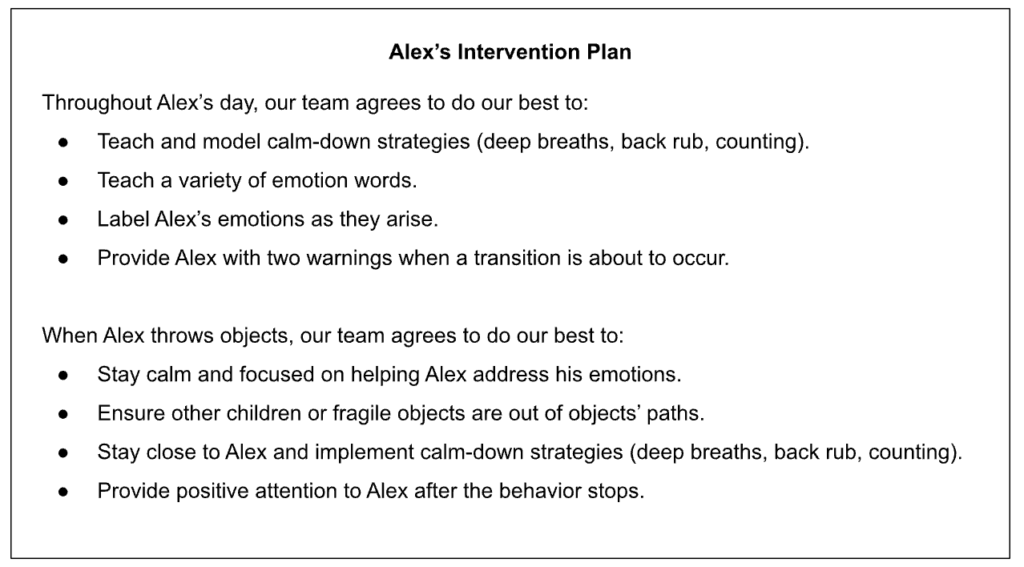By Grace Sawyer
Young children often receive supports, services, and care in a variety of settings (e.g., early intervention programs and childcare, preschool, and private occupational therapy). Children often engage in challenging behavior across settings; therefore, adults should collaborate across settings to prevent and address challenging behavior (DEC, 2017). The Division for Early Childhood provides recommendations that practitioners can use to team and collaborate across settings.
What team members should collaborate?
Any adult who provides care or services to a child should be considered a team member. Families are essential team members, given their expertise about their children and their primary caregiving role. Professionals on the team may include the child’s early intervention/early childhood special education providers, childcare providers, medical staff, or related service providers (e.g., play therapist, social worker). Military families also may have a school liaison and/or an Exceptional Family Member Program (EFMP) Family Support Provider as members of the team. Also, some children may receive additional supports such as transportation or community-based services (e.g., public housing assistance, and parent education programs). It is critical to identify potential team members when addressing a child’s challenging behavior with a family.
Recommendations for Effective Collaboration
- Use team members’ unique knowledge and expertise in assessment and intervention planning. Practitioners should remember that all team members have different experiences with the child and with challenging behavior. These experiences should be given consideration, as each person’s insights contribute to the holistic portrait of the child. Additionally, practitioners come from diverse backgrounds and training; what one practitioner notices about a behavior may be completely different from what another individual “sees.” When team members share that knowledge and their experiences, they can create a shared understanding of how best to support a child.
- Develop consistent guidance on how to prevent and respond to challenging behavior. The aim of teaming to address challenging behavior should be to develop and implement a consistent intervention plan across settings (DEC, 2017). These plans should be realistic and sustainable; for example, an intervention plan that requires three adults to be in the room may be unrealistic at home or in a childcare setting. Team members can clearly articulate the plan and share it with all interested individuals (Kinder et al., 2021). See the example that follows for ideas.

Note: Adapted from Articulated Classroom Guidance Principles in Kinder, K. A., Quesenberry, A. C., & Cheatham, G. A. (2021). Building collaborative relationships with colleagues. In M. L. Hemmeter, M. M. Ostrosky, & L. Fox (Eds.), Unpacking the Pyramid Model: A practical guide for preschool teachers (pp. 27-37). Brookes Publishing.
- Create avenues for group communication and problem-solving. Successful interventions do not stop at the initial planning stage. When team members begin implementing an intervention, they will likely experience successes, hiccups, and challenges. Practitioners should create methods of communication for the team, such as a recurring meeting or team-wide email thread. This allows team members to problem-solve as challenges arise, ensuring that the team continues working collaboratively to support the child. Practitioners can model positive group communication by celebrating a child’s successes as well as participating in problem-solving. Finally, group communication is a great avenue for sharing resources like the intervention plan shared above.
- Identify a primary liaison between the family and practitioners from each setting. Sometimes, a child’s team consists of many adults. Having several voices can be empowering at times, but it also may be overwhelming, especially during times of stress or transition. Practitioners from each setting can select a primary liaison for communication purposes and to attend and represent others at meetings. For example, a child’s early intervention team may select the special instructor as the team liaison or the childcare center director may serve as the liaison for that setting. Selecting representatives can streamline communication and reduce confusion, especially for families.
Young children who engage in challenging behavior across settings benefit from consistent interventions provided by a collaborative interdisciplinary team. Practitioners can use their own knowledge and others’ expertise to best support the children in their care.
You can find links to helpful Tip Sheets and Resources from the Illinois Early Learning Project in this document.
References
Division for Early Childhood. (2014). DEC recommended practices in early intervention/early childhood special education 2014. http://www.decsped.org/recommendedpractices
Division for Early Childhood. (2017). Position statement on challenging behavior and young children. https://www.decdocs.org/position-statement-challenging-beha
Kinder, K. A., Quesenberry, A. C., & Cheatham, G. A. (2021). Building collaborative relationships with colleagues. In M. L. Hemmeter, M. M. Ostrosky, & L. Fox (Eds.), Unpacking the Pyramid Model: A practical guide for preschool teachers (pp. 27-37). Brookes Publishing.















